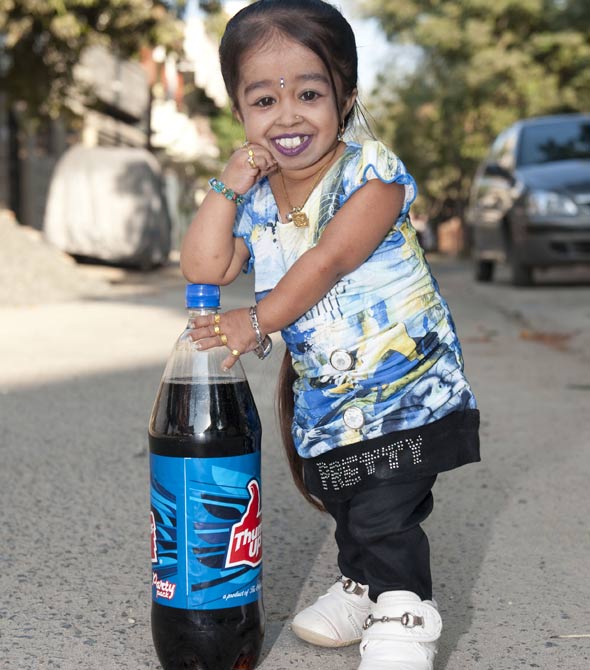Who is the world's smallest lady?
The world's smallest lady is Jyoti Amge, an Indian actress who holds the Guinness World Record for being the smallest living woman. She was born in 1993 and stands at just 2 feet 0.6 inches (62.8 cm) tall. Amge's small stature is due to a rare genetic disorder called achondroplasia, which affects bone growth. Despite her physical challenges, Amge has achieved great success in her life. She has starred in several Bollywood films and television shows, and she is also a motivational speaker.
Amge's story is an inspiring one, and it shows that anything is possible if you set your mind to it. She is a role model for people with disabilities all over the world, and she proves that you can achieve your dreams no matter what your physical limitations may be.
The world's smallest lady is a reminder that we should all embrace our differences and celebrate what makes us unique. Amge's story is a powerful example of how one person can make a difference in the world.
World's Smallest Lady
The world's smallest lady is a fascinating topic that encompasses various dimensions, including medical conditions, social perceptions, and personal achievements. Here are five key aspects that explore the essence of this topic:
- Medical Condition: Achondroplasia, a genetic disorder that affects bone growth
- Physical Characteristics: Exceptionally short stature, typically below 3 feet
- Social Perceptions: Challenges and discrimination faced due to physical differences
- Personal Triumphs: Remarkable achievements in various fields, such as entertainment and advocacy
- Inspirational Impact: Role models for people with disabilities, promoting inclusivity and self-acceptance
The world's smallest lady is a testament to the strength and resilience of the human spirit. These individuals face unique challenges, yet they often achieve extraordinary things. Their stories remind us that we should embrace our differences and celebrate the diversity that makes our world a richer place.
| Name | Jyoti Amge |
| Date of Birth | December 16, 1993 |
| Place of Birth | Nagpur, India |
| Height | 2 feet 0.6 inches (62.8 cm) |
| Occupation | Actress, motivational speaker |
Medical Condition
Achondroplasia is a genetic disorder that affects bone growth. It is characterized by short stature, short limbs, and a large head. Achondroplasia is caused by a mutation in the FGFR3 gene, which is responsible for producing a protein that helps to regulate bone growth. The mutation results in the production of a defective protein, which leads to the development of achondroplasia.
Achondroplasia is the most common form of dwarfism, and it affects about 1 in 25,000 people. It is inherited in an autosomal dominant manner, which means that only one copy of the mutated gene is needed to cause the disorder. However, in about 80% of cases, achondroplasia is caused by a new mutation that occurs spontaneously.
The symptoms of achondroplasia can vary, but they typically include short stature, short limbs, a large head, and a prominent forehead. People with achondroplasia may also have difficulty breathing, sleep apnea, and other health problems. The severity of the symptoms can vary depending on the individual.
There is no cure for achondroplasia, but there are treatments that can help to manage the symptoms. These treatments may include surgery to correct bone deformities, medication to help with breathing and sleep apnea, and physical therapy to improve mobility.
People with achondroplasia can live full and active lives. They may face some challenges, but they can achieve anything they set their minds to. They are an inspiration to us all.
Physical Characteristics
The exceptionally short stature, typically below 3 feet, is a defining physical characteristic of the world's smallest lady. This unique feature stems from a genetic disorder called achondroplasia, which affects bone growth. Individuals with achondroplasia have disproportionately short limbs and a large head, resulting in a petite stature.
- Limited Mobility and Dexterity: The short stature can impact mobility and dexterity, affecting daily activities such as reaching objects or navigating spaces designed for average-height individuals.
- Health Implications: The physical characteristics associated with achondroplasia can lead to potential health concerns, including breathing difficulties, sleep apnea, and spinal curvature.
- Social Challenges: Exceptionally short stature can sometimes attract unwanted attention and social stigma, leading to challenges in social interactions and self-esteem.
- Adaptive Strategies: Individuals with achondroplasia often develop adaptive strategies to overcome physical limitations, such as using modified furniture, assistive devices, and customized clothing.
Despite the physical challenges, individuals with exceptionally short stature demonstrate resilience and determination. They embrace their unique qualities and strive to live fulfilling lives. Their stories inspire us to recognize the diversity of human experiences and to celebrate the beauty in our differences.
Social Perceptions
Individuals with exceptionally short stature, particularly those referred to as the "world's smallest lady," often encounter various social perceptions and challenges:
- Stigma and Prejudices: Societal norms and stereotypes can lead to stigmatization, prejudice, and discrimination against individuals with dwarfism. Misconceptions and biases can hinder their opportunities in employment, education, and social interactions.
- Limited Accessibility: Physical environments and public spaces are frequently not designed with the needs of individuals with short stature in mind. This inaccessibility can create barriers to mobility, participation, and independence, restricting their quality of life.
- Patronizing Attitudes: Some individuals may exhibit patronizing or condescending attitudes towards people with dwarfism, treating them as childlike or less capable. Such attitudes can be demeaning and undermine their sense of self-worth.
- Cyberbullying and Social Media Harassment: In the digital age, individuals with dwarfism may face online harassment, cyberbullying, and insensitive comments. These experiences can have a negative impact on their mental health and well-being.
These social perceptions and challenges highlight the need for greater awareness, understanding, and inclusion of individuals with dwarfism in society. Creating an equitable and respectful environment where their rights and dignity are upheld is crucial for their empowerment and full participation in all aspects of life.
Personal Triumphs
Despite the challenges they face, individuals with exceptionally short stature, including the "world's smallest lady," have demonstrated remarkable triumphs in various fields, inspiring and empowering others. These achievements not only showcase their talents and abilities but also challenge societal perceptions and promote inclusivity.
- Entertainment: Several individuals with dwarfism have made significant contributions to the entertainment industry, breaking stereotypes and captivating audiences. They have starred in films, television shows, and stage productions, bringing unique perspectives and experiences to the forefront.
- Advocacy: Many individuals with dwarfism have become vocal advocates for themselves and others with disabilities. They work tirelessly to raise awareness, challenge discrimination, and promote equal opportunities in all aspects of life.
- Business and Entrepreneurship: Some individuals with dwarfism have established successful businesses and ventures, demonstrating their entrepreneurial spirit and drive. They serve as role models for others with disabilities, proving that physical stature does not limit their potential for achievement.
- Sports: Individuals with dwarfism have also made their mark in the world of sports, competing and excelling in various disciplines. They challenge perceptions of what is possible, inspiring others to pursue their athletic goals regardless of their physical differences.
These personal triumphs are a testament to the resilience, determination, and talent of individuals with exceptionally short stature. Their achievements not only inspire but also contribute to a more inclusive and equitable society where everyone has the opportunity to reach their full potential.
Inspirational Impact
Individuals with exceptionally short stature, including the "world's smallest lady," serve as powerful role models for people with disabilities, promoting inclusivity and self-acceptance. Their journeys and achievements inspire others to embrace their own unique qualities and challenge societal norms.
- Overcoming Adversity: These individuals exemplify resilience and determination in overcoming physical challenges and societal barriers. Their stories empower others with disabilities to believe in their own abilities and pursue their dreams.
- Challenging Stereotypes: By breaking away from societal expectations and showcasing their talents, they challenge misconceptions and stereotypes associated with dwarfism. They demonstrate that physical differences do not define an individual's worth or potential.
- Promoting Inclusivity: Their presence in various fields, such as entertainment and advocacy, raises awareness and promotes inclusivity for people with disabilities. They advocate for accessible and equitable environments, breaking down barriers to participation.
- Inspiring Self-Acceptance: By embracing their unique identities and sharing their experiences, these individuals inspire others with disabilities to embrace their own differences and cultivate self-acceptance.
The inspirational impact of the "world's smallest lady" and others with dwarfism extends beyond the disability community. They remind us all of the importance of valuing diversity, celebrating uniqueness, and creating a society where everyone has the opportunity to thrive.
Frequently Asked Questions about the World's Smallest Lady
This section addresses common questions and misconceptions surrounding individuals with exceptionally short stature, including the "world's smallest lady."
Question 1: What causes exceptionally short stature?
Answer: Exceptionally short stature can be caused by various genetic disorders, including achondroplasia, the most common form of dwarfism. Achondroplasia affects bone growth, resulting in disproportionately short limbs and a large head.
Question 2: What are the common challenges faced by individuals with dwarfism?
Answer: Individuals with dwarfism may encounter challenges such as mobility limitations, social stigma, discrimination, and accessibility issues. However, with support and accommodations, they can live fulfilling lives.
Question 3: Can individuals with dwarfism achieve success in various fields?
Answer: Yes, individuals with dwarfism have made significant contributions in entertainment, advocacy, business, and other fields. They demonstrate resilience, determination, and talent, challenging societal perceptions and inspiring others.
Question 4: How can we promote inclusivity for individuals with dwarfism?
Answer: Promoting inclusivity involves raising awareness, challenging stereotypes, creating accessible environments, and valuing diversity. It is essential to treat individuals with dwarfism with respect and dignity.
Question 5: What are the health considerations for individuals with dwarfism?
Answer: Individuals with dwarfism may have specific health concerns related to their condition, such as breathing difficulties, sleep apnea, and spinal curvature. Regular medical care and management are crucial for their well-being.
Question 6: How can we support individuals with dwarfism in living fulfilling lives?
Answer: Supporting individuals with dwarfism involves providing equal opportunities, fostering a sense of community, and celebrating their unique abilities. Creating an inclusive society empowers them to achieve their full potential.
Summary: Individuals with exceptionally short stature, including the "world's smallest lady," face unique challenges but also possess remarkable strengths and talents. They are role models for inclusivity and self-acceptance, reminding us to value diversity and create a society where everyone can thrive.
Transition to the next article section: This section explores the medical condition of achondroplasia and its impact on individuals' lives.
Conclusion
The exploration of the "world's smallest lady" has provided a nuanced understanding of the unique experiences and challenges faced by individuals with exceptionally short stature. It highlights the importance of recognizing the diversity of human conditions and celebrating the strength and resilience of those who navigate life with physical differences.
Beyond the specific case of the "world's smallest lady," this article serves as a reminder to foster inclusivity, challenge societal norms, and create a world where all individuals, regardless of their physical attributes, have the opportunity to reach their full potential. By embracing a spirit of empathy and understanding, we can build a more equitable and just society for all.
Tracking Down SZA's Father: A Journey To Uncover Her Roots
TD Jakes Resigned From The Potter's House: True Or Not?
Meet Aubrey Wyatt: A Photographer's Journey

to Linda Onu's Blog Meet the world's smallest Woman (photos)

Funny Smallest Woman in the World All Funny